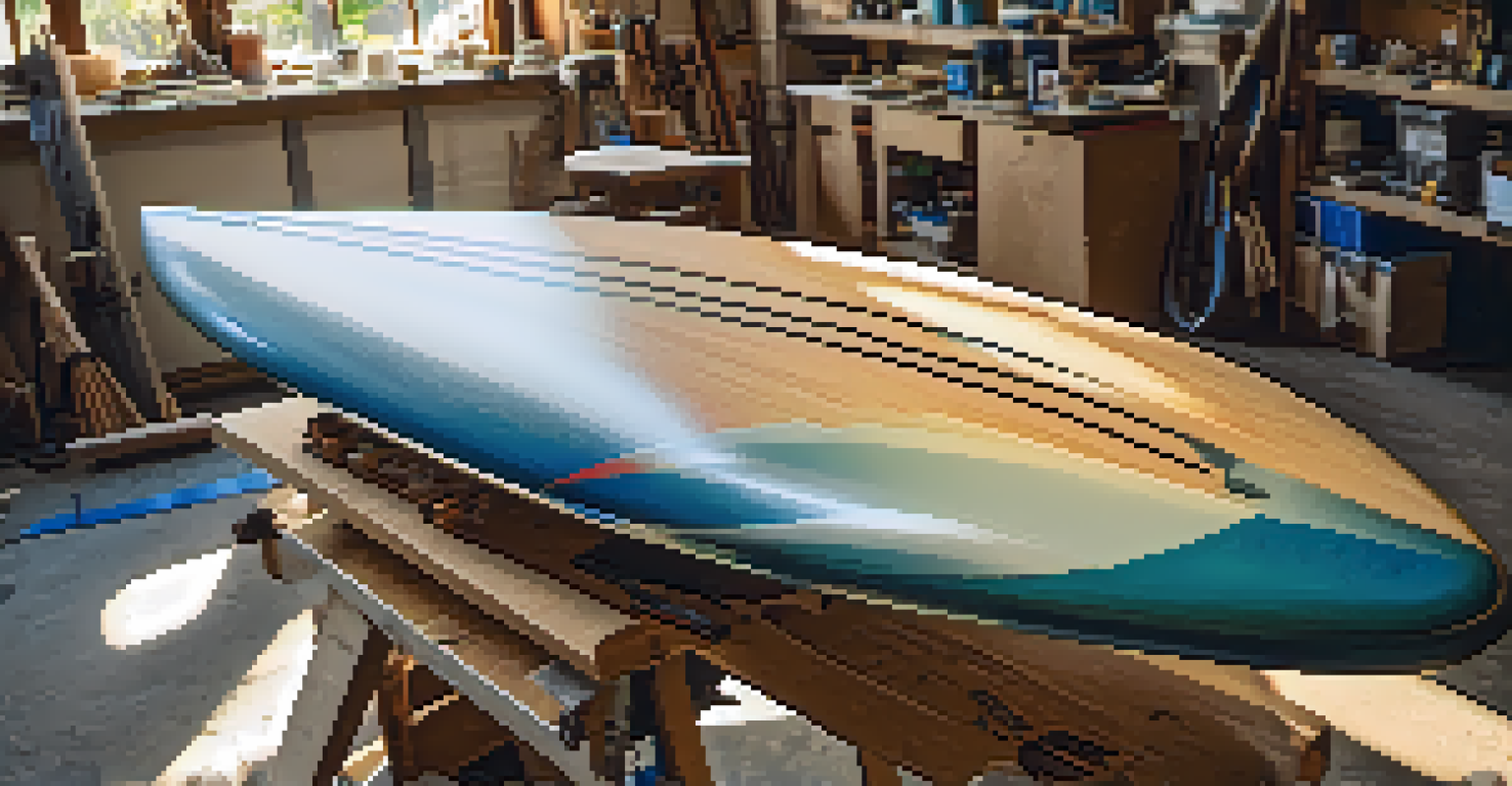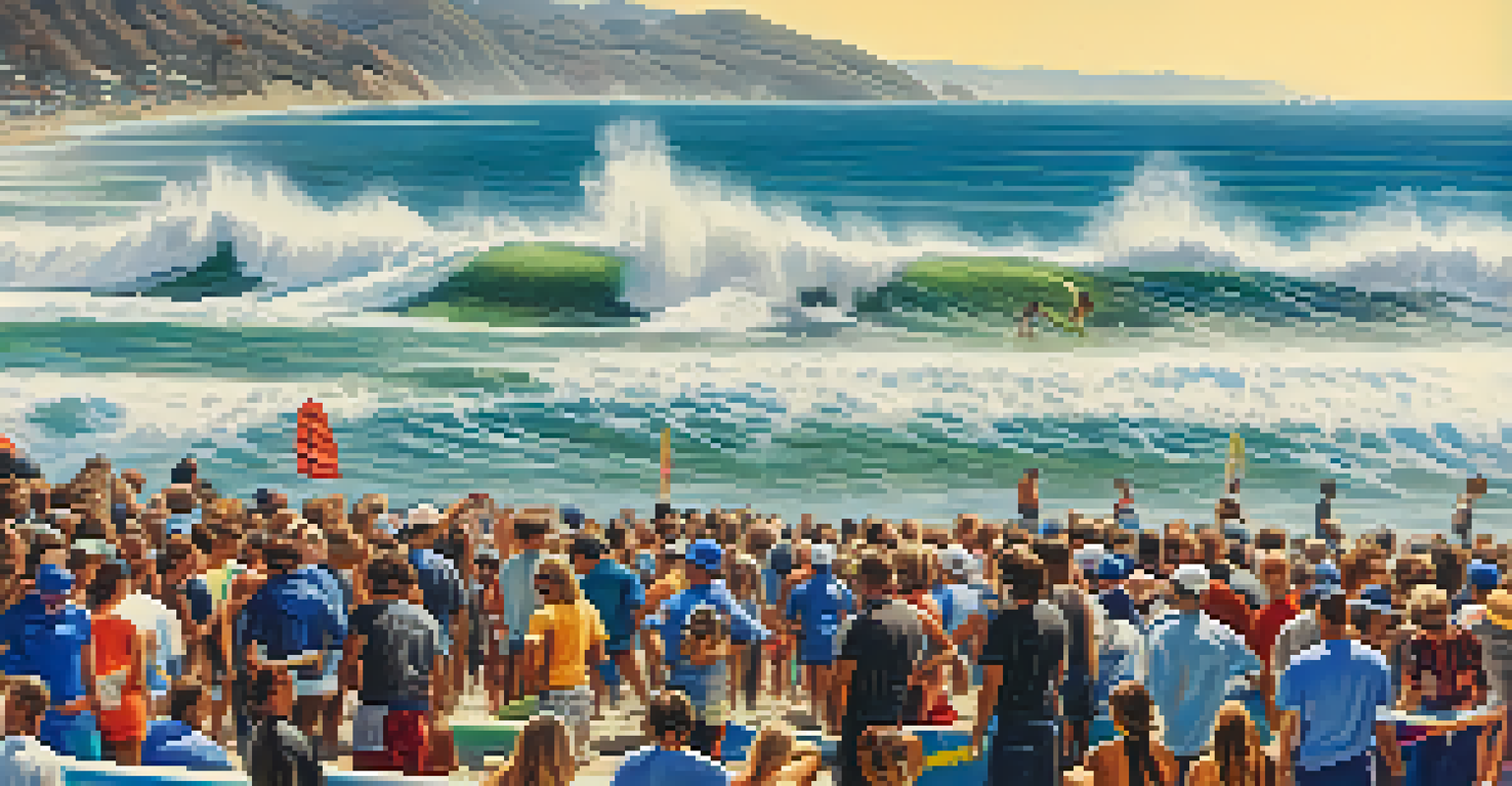The Role of Malibu in Shaping Surfboard Technology

Malibu: The Birthplace of Modern Surf Culture
Malibu is often regarded as the cradle of modern surf culture, where it all began in the 1950s. The iconic beaches attracted pioneering surfers who shaped not just the sport but also the tools they used, particularly surfboards. As surfers flocked to its waves, they began experimenting with different board shapes and materials, laying the groundwork for surfboard technology as we know it today.
Surfing is not just a sport; it's a lifestyle that embodies the spirit of freedom and creativity.
The natural beauty and consistent waves of Malibu provided the perfect testing ground for new surfboard designs. Local surfers, eager to improve their performance, began to collaborate with shapers to create boards that suited their unique styles and the specific conditions of the Malibu surf. This collaborative spirit fueled innovation and set the stage for a thriving surfboard industry.
Moreover, Malibu's influence extended beyond just the boards themselves; it helped foster a community that valued creativity and experimentation. Surfers became not only riders of the waves but also innovators, continuously pushing the boundaries of what surfboards could achieve. This ethos of innovation and community spirit has endured, making Malibu a key player in the history of surfboard technology.
The Evolution of Surfboard Materials
In the early days, surfboards were primarily made from wood, which, while aesthetically pleasing, was heavy and not very maneuverable. As Malibu surfers sought better performance, they turned to lighter materials, such as foam and fiberglass, which revolutionized the way boards were designed and constructed. This shift allowed for greater speed, agility, and overall performance in the water.

The transition to foam and fiberglass marked a significant turning point in surfboard technology. These materials not only made boards lighter but also allowed for more intricate shapes and designs, catering to different types of waves. Malibu's surf culture embraced these innovations, with local shapers experimenting with various forms and sizes to create boards that could tackle the diverse conditions of the coastline.
Malibu: Surf Culture's Birthplace
Malibu is celebrated as the birthplace of modern surf culture, where pioneering surfers began experimenting with surfboard designs in the 1950s.
As technology advanced, so did the materials used in surfboard production. From epoxy resins to advanced composites, Malibu has been at the forefront of adopting and refining these innovations. The result? A new generation of surfboards that not only perform better but are also more sustainable, reflecting the surfers’ growing awareness of their environmental impact.
Innovative Surfboard Shapes from Malibu Shapers
Malibu's surfboard shapers have played a pivotal role in defining the shapes that are now standard in the industry. Iconic designs like the 'Malibu fish' and the 'longboard' originated from local shapers' experimentation with different outlines and rocker profiles. These innovations have helped surfers adapt to various wave conditions, ensuring they can ride the waves efficiently.
The ocean stirs the heart, inspires the imagination, and brings eternal joy to the soul.
One of the most notable contributions from Malibu shapers is the development of the shortboard, which emerged in the 1970s. This design allowed surfers to perform more radical maneuvers and tricks, transforming the sport into a more dynamic and competitive activity. The popularity of the shortboard can be traced back to the vibrant surf scene in Malibu, which inspired countless surfers to push their limits.
Additionally, Malibu has been a nurturing ground for collaboration between surfers and shapers. This synergy has led to the creation of custom boards tailored to individual styles and preferences, further advancing surfboard technology. As surfers share their experiences and feedback, shapers continue to innovate, ensuring that Malibu remains a hub for cutting-edge surfboard designs.
The Influence of Competitive Surfing on Board Design
As competitive surfing gained popularity in the 1980s and 1990s, Malibu became a key player in shaping surfboard technology to meet the demands of professional athletes. Competitions like the Malibu Invitational showcased the best surfers and served as a platform for testing new designs. This competitive environment spurred innovation, leading to faster, more responsive boards that could handle the pressures of high-stakes surfing.
Malibu's iconic surf competitions also attracted global attention, inspiring shapers to refine their boards for elite performance. Surfers began to prioritize speed, maneuverability, and control, pushing shapers to explore new designs and materials. This symbiotic relationship between competition and innovation has led to a cycle of continuous improvement in surfboard technology.
Innovation in Surfboard Materials
The shift from heavy wooden surfboards to lighter foam and fiberglass marked a significant evolution in surfboard technology, enhancing performance.
Moreover, the visibility of Malibu as a surf competition hotspot helped establish trends that influenced board designs worldwide. The performance of top surfers in Malibu set benchmarks for aspiring athletes, motivating them to seek out the latest advancements in surfboard technology. As a result, Malibu has solidified its reputation as a leading force in the evolution of surfboards.
Sustainability and Eco-Friendly Innovations
In recent years, Malibu has taken significant strides towards sustainability in surfboard production. As awareness of environmental issues has grown, local shapers have begun exploring eco-friendly materials and practices. This shift not only addresses ecological concerns but also resonates with surfers who value a connection to nature, making Malibu a leader in sustainable surfboard technology.
The use of recycled materials and bio-based resins has become increasingly common among Malibu shapers. These innovations help reduce the carbon footprint associated with surfboard manufacturing while maintaining high performance standards. Surfers are now able to ride boards that reflect their commitment to the environment, creating a deeper connection between their sport and their values.
Furthermore, community initiatives in Malibu promote the importance of sustainability in surfing. Local surf schools and organizations are teaching aspiring surfers about eco-friendly practices, encouraging the next generation to prioritize the health of the oceans. This focus on sustainability not only enhances Malibu's reputation but also sets a precedent for the surf industry as a whole.
The Role of Technology in Surfboard Design
The integration of technology into surfboard design has revolutionized the industry, and Malibu has been at the forefront of these advancements. From computer-aided design (CAD) to advanced manufacturing techniques, shapers in Malibu are leveraging technology to create boards with precision and efficiency. These innovations allow for experimentation and customization like never before.
One exciting development is the use of 3D printing in surfboard construction. Malibu shapers are beginning to experiment with 3D-printed components, which can enhance performance while reducing waste. This fusion of technology and craftsmanship offers surfers access to boards that are not only high-performing but also tailored to their specific needs.
Sustainability in Surfboard Design
Recent trends in Malibu emphasize sustainability, with local shapers adopting eco-friendly materials and practices to align with surfers' values.
Additionally, smart technology is making its way into surfboards, with features like embedded sensors that track performance metrics. These advancements provide surfers with valuable insights into their riding style, helping them make data-driven improvements. Malibu remains a hub for these technological innovations, ensuring that surfboard design continues to evolve in exciting ways.
The Future of Surfboard Technology in Malibu
As we look to the future, Malibu will undoubtedly continue to play a crucial role in shaping surfboard technology. The ongoing collaboration between surfers, shapers, and technology experts will drive further innovations that enhance performance and sustainability. With each new generation of surfers, the legacy of Malibu's influence on surfboard design will only strengthen.
Emerging trends, such as electric surfboards and advanced materials, are already being explored by Malibu's innovative community. These developments promise to redefine what is possible in the world of surfing, offering new experiences for surfers of all skill levels. Malibu's commitment to pushing the boundaries ensures it remains a key player in this evolving landscape.

Ultimately, the spirit of creativity and experimentation that defines Malibu will continue to inspire future surfboard innovations. As surfers and shapers navigate the challenges of climate change and technological advancements, the legacy of Malibu as a leader in surfboard technology will endure, making waves for generations to come.